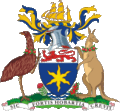History
It derives its name from Captain William Bellamy Risdon, second officer of the ship Duke of Clarence, [2] which visited the area as part of Sir John Hayes' expedition in 1793. [3] Risdon Post Office opened on 1 July 1864. It was named "Gregson" during 1911. Historical landmarks in Risdon include Cleburne Homestead, a house next to the Bowen Bridge built in the 1820s, Saracen's Head Inn, a charming sandstone hotel built in c. 1828, Risdon Brook Bridge, a sandstone-arched bridge over the Risdon Brook built in 1858, and finally St. Margaret's Church, an abandoned wooden church that opened in 1867. [4]
Zinc works
Between 1916 and 1920 Electrolytic Zinc developed a zinc refinery, known as the "Risdon works", and an eponymously named suburb.
In 1956, as part of the refinery complex, EZ started a sulphate of ammonia plant. [5]
The owners of the plant in 1987 considered expansion of the refinery. [6]
Currently the zinc works and former workers housing area [7] are found in Lutana. [8]
This page is based on this
Wikipedia article Text is available under the
CC BY-SA 4.0 license; additional terms may apply.
Images, videos and audio are available under their respective licenses.


